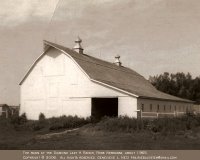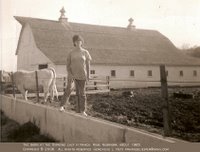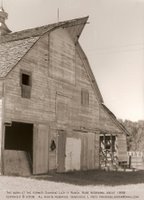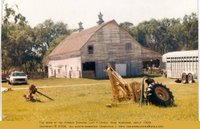History and Old Stuff...
When we look back at pioneer days on the prairie, it's easy to imagine the lives of the settlers as more idyllic than most actually were.
We've all watched "Little House On the Prairie," and many of us have read the Laura Ingalls Wilder books! The world would be a poorer place without the wonderful stories of her childhood that Laura recorded for us. She truthfully recorded many of the difficulties and dangers that her family faced, and she wrote with great good cheer and a determined optimism. I don't doubt that her family had that attitude and that it helped them to survive many hardships, but it gives a rosy hue to the picture that Laura paints.
Willa Cather wrote realistically about the grim circumstances some homesteaders found themselves in. In her stories about Nebraska, she noted that many were ill-suited for life on the raw prairie. Some came from cities and had no experience at all with farming. They knew nothing about plants and animals. Others lacked the financial resources and emotional strength to hang on through droughts, grasshopper attacks, tornados, blizzards and prairie fires.
Here is a vignette of one woman's life from Cather's short story, "A Wagner Matinée"
My Aunt Georgiana had been a music teacher at the Boston Conservatory, somewhere back in the latter sixties. One summer, while visiting in the little village among the Green Mountains where her ancestors had dwelt for generations, she had kindled the callow fancy of the most idle and shiftless of all the village lads, and had conceived for this Howard Carpenter one of those extravagant passions which a handsome country boy of twenty-one sometimes inspires in an angular, spectacled woman of thirty. When she returned to her duties in Boston, Howard followed her, and the upshot of this inexplicable infatuation was that she eloped with him, eluding the reproaches of her family and the criticisms of her friends by going with him to the Nebraska frontier. Carpenter, who, of course, had no money, had taken a homestead in Red Willow County, fifty miles from the railroad. There they had measured off their quarter section themselves by driving across the prairie in a wagon, to the wheel of which they had tied a red cotton handkerchief, and counting off its revolutions. They built a dugout in the red hillside, one of those cave dwellings whose inmates so often reverted to primitive conditions. Their water they got from the lagoons where the buffalo drank, and their slender stock of provisions was always at the mercy of bands of roving Indians. For thirty years my aunt had not been further than fifty miles from the homestead.
Quoted from "A Wagner Matinée" by Willa Cather. Originally published in Everybody's Magazine in 1904.
"A Wagner Matinée", source of the quotation above, is the story of a woman and her nephew. He was brought up as a rough homestead boy, though he learned Latin and music under his aunt's care and training. As an adult, he goes to the city and becomes a suave and polished gentleman (on the surface at least). His aunt has undergone an opposite transformation, from a talented lady musician to an overworked prairie pioneer and farm wife. Both aunt and nephew have opportunity at the matinée to recall and marvel at their former and current lives.
It's a poignant and touching look at a relationship, and I found myself identifying to an extent with the nephew, a person who left the homestead and went far away. I'm sure the nephew is a representation of Willa Cather herself. She went to New York City and became a successful editor and writer, but she could never forget where she was from -- Red Cloud, Nebraska, was part of her. She knew it deeply. That's what makes her stories so powerful and authentic, even 100 years later.
"A Wagner Matinée" is also a look at the darker side of the homestead experience. Loss and sacrifice are part of the great story of America's homesteaders. I pay lip service to that fact often, but I was still surprised at the bleakness I saw and felt as I was drawn into this story.
I took my Mennonite neighbor to the chiropractor today. While I was waiting, I read a couple of Willa Cather stories. I have been thinking about this one ever since.

Technorati tags:



